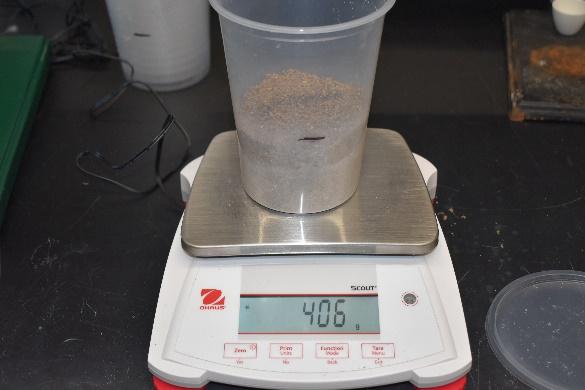Acclimation of in vitro grown individual lines of big sagebrush (Artemisia tridentata) to ex vitro conditions in support of genotype-by-environment experiments and restoration
Peggy Martinez, Marcelo Serpe, Rachael Barron, Sven Buerki
Disclaimer
This protocol has been tested and applied on in vitro diploid individual lines of Artemisia tridentata subsp. tridentata (using protocol described in Barron et al., 2020) and it might require minor adjustments to work on the other subspecies and cytotypes.
Abstract
The following protocol describes the ex vitro , hardening and acclimation of in vitro grown genetically identical plantlets (i.e. clones) of Artemisia tridentata ssp. tridentata (Asteraceae). The goal of this protocol is to create functional clonal lines of Artemisia tridentata to be used in genotype-by-environment (GxE) experiments. Overall, the protocol consists of the following four major steps and takes 16 weeks to complete on 11-16-week old in vitro plantlets: i) transfer in vitro plantlets from modified Murashige & Skoog (MMS) media to a sand and vermiculite soil mixture (4:1 ratio; hereafter referred to as sandy soil) in an enclosed, high humidity vessel to initiate plantlet establishment and root growth (four weeks); ii) gradually open vessels to initiate dropping of in vitro leaves and growth of functional leaves (four weeks) associated with decreased of humidity and increased gas exchange; iii) establishing a watering regime to promote and maintain growth of functional plantlets (six weeks) and iv) transfer plantlets into a more complex soil mixture (similar to natural conditions composed of sand, silt and vermiculite at 2:1.5:0.5 ratio; referred to as silt soil) in an open vessel to complete acclimation; especially hardening of the root system (two weeks or more depending on specific needs). Upon completion, the sagebrush plantlets will be exhibiting a similar phenotype as sagebrush seedlings. Finally, although optional, we are encouraging users to conduct stem xylem pressure measurements on acclimatized and well-watered plantlets prior to starting GxE experiments to evaluate their hydraulic conductivity and overall level of stress.
Before start
Steps
Prepare sandy soil with nutrient solution
Prepare sandy soil
-
Mix play sand and vermiculite to a 4:1 v/v (sand/vermiculite) in large plastic tub (hereafter referred to as sandy soil). If play sand is very dry, add enough DI water to moisten the sandy soil mixture.
NoteSand/vermiculite soil mixture will slightly hold form when pressed into a ball. -
Tare Phyto Con vessel (946mL) on the balance and add 406 g of the sandy soil mixture.
Media preparation
- Using a graduated cylinder, add 500 mL DI water to an Erlenmeyer flask with stir bar and place onto the stir plate. Turn on stir plate to ~300 rpm, no heat is needed.
- On the balance, weigh out 2.2 g Murashige and Skoog + Gamborg vitamins into weigh boat and add to flask. Mix until dissolved.
- Pipette 1 mL Plant Preservative Mixture (PPM) to flask. Add 500 mL DI water to media mixture to bring to 1L volume.
pH correction of the media
- Place calibrated pH meter into the 1/2MS + PPM solution created in Step 2.
- Add 0.1M KOH dropwise to the solution until pH 5.8 is reached.
Note
The solution has little buffering capacity so wait for pH meter to stabilize before adding more 0.1M KOH. 5 drops at a time works well at this volume.
Add media to sand mixture and autoclave
- Pour 40 mL of the 1/2MS + PPM solution into a graduated cylinder and pour into prepared Phyto Con vessels.
- Place lids lightly on top of vessels.
Steam sterilize the prepared Phyto Con vessels at 15 psi, 121ºC, for one hour to sterilize the soil and vessels. * After sterilization process, press lids down tightly.
- Allow soil + media to cool thoroughly before beginning transplant procedure (step 5 onwards).
Transfer plantlets from in vitro to ex vitro conditions
Sterilize and prepare Laminar flow clean bench for transplant of in vitro plantlets (Fig. 1) in vitro plantlets (Fig. 1)
-
Sterilize the inside of the laminar flow clean bench with 70% v/v ethanol. Wipe the outside of the culture vessels containing in vitro grown plantlets and Phyto Con vessels with 70% v/v ethanol prior to placing inside the laminar flow clean bench. Pour a small amount of 90% v/v ethanol into large petri dishes and allow to dry in the laminar flow clean bench. Place forceps and scoop into 90% v/v ethanol. Heat bead sterilizer to 280°C.

Fig 1. PhytoCon vessels and in vitro grown plantlets prior to transplant.
Transplanting in vitro grown plantlets into ex vitro conditions (Fig. 2) grown plantlets into ex vitro conditions (Fig. 2)
-
Working inside the laminar flow clean bench, sterilize scoop by dipping it into 90% v/v ethanol and placing in bead sterilizer for ~30 seconds. Open Phyto Con vessel and dig a small ~3 cm deep hole into the soil medium.
-
Rinse scoop with DI water to remove excess soil and place back into 90% v/v ethanol. Then, sterilize forceps using the same procedure used to sterilize the scoop.
-
Allow forceps to cool slightly.
-
Open the culture vessel containing an in vitro grown plantlet and grasp the base of the stem (right above the sterile media). Gently pull the plantlet and roots out of the media (Fig. 2).
-
If media clings to the roots, place into sterile petri dish and using forceps, scrape off media.
NoteCAUTION: Take care not to rip roots at this step. -
In the Phyto Con vessel, feed roots into the small whole previously dug into the soil media. Gently cover roots, and press soil down lightly. Replace lid tightly and label vessel.
-
Continue steps until all plantlets are transplanted.

Acclimation Phase
Plant Tissue Culture Chamber (Fig. 3)
- After plantlets are transplanted, place Phyto Con vessels into the plant tissue culture chamber to begin acclimatization. Tissue chamber environment should be at 24°C and PAR ~128 µmol photons × s⁻¹ × m⁻² (= same abiotic conditions as with the in vitro plantlets). The particular chamber pictured uses fluorescent bulbs.
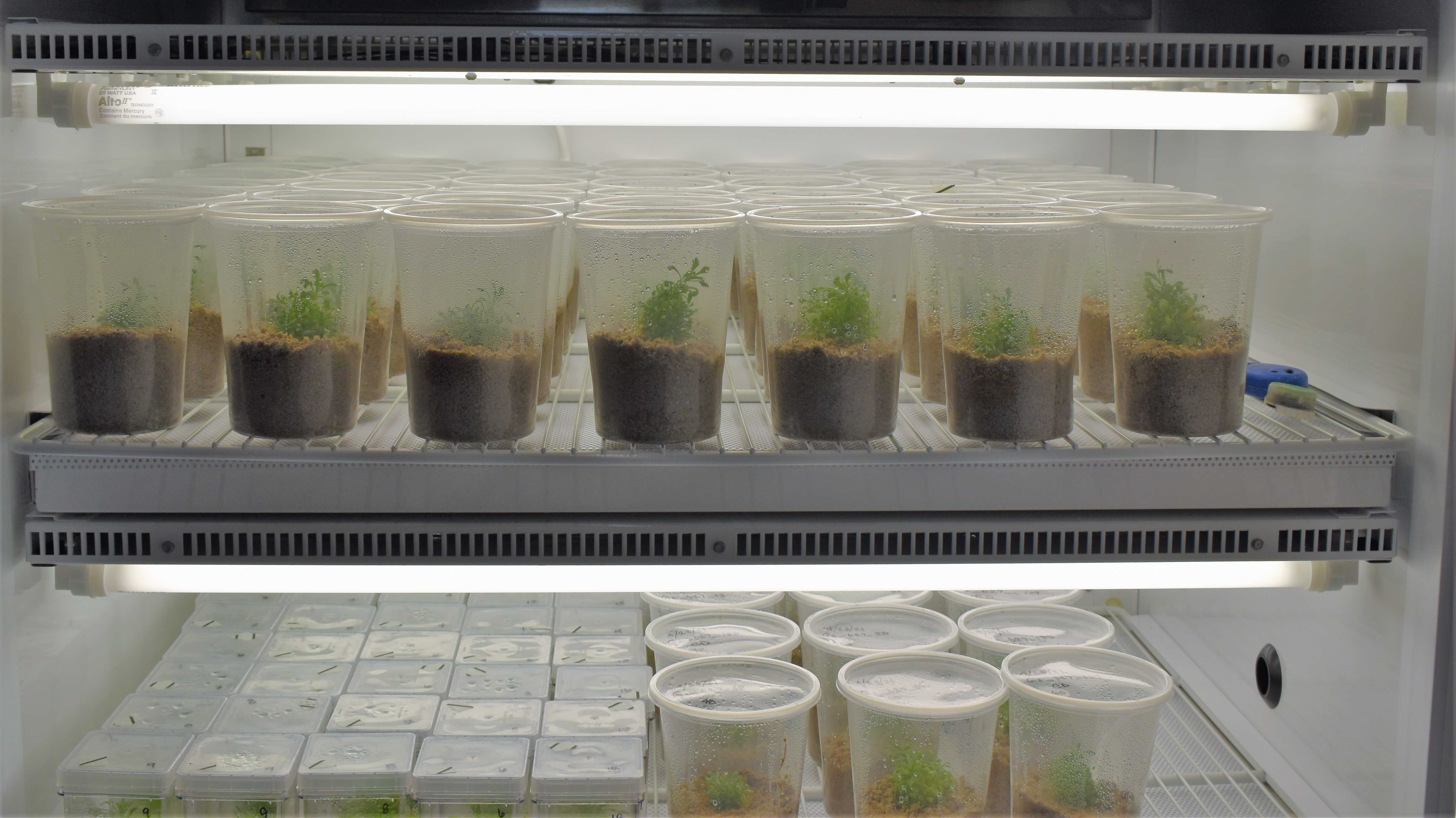
Move closed vessels into the lab (Fig. 4)
- Move closed Phyto Con vessels into the laboratory to adjust plantlets to variable light intensity. Growth lights are fluorescent bulbs with PAR ~82 µmol photons × s⁻¹ × m⁻² and temperature is between 22 and 24°C. Vessels stay closed during this 2-week period and you will observe condensation on the sides (Fig. 4).

Crack open vessels in the laboratory (Fig. 5)
- Open Phyto Con vessels (see Fig. 5) to allow for gas exchange to occur. Remove lids and replace slightly off center to minimize water loss and encourage phenotype changes (morphogenesis) to occur.
Note
In vitro leaves will drop and newly adapted leaves will set (Fig. 5).
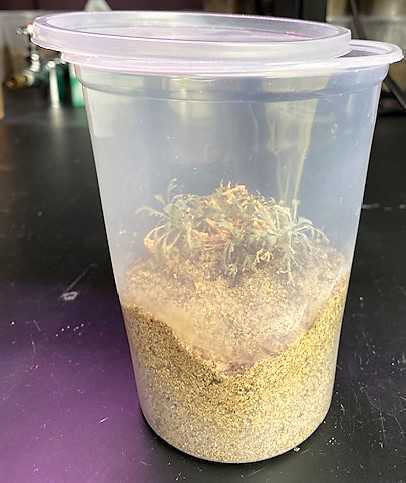
Fully open vessels and water as needed (Figs. 6,7, 8)
- During this step, lids will be fully removed as determined by plantlet morphology change (see Fig. 6,7 for an example), if there is not a sufficient phenotypic change (= new adapted leaves, which are sage color and covered of trichomes), removing the lid completely will cause plantlet death.
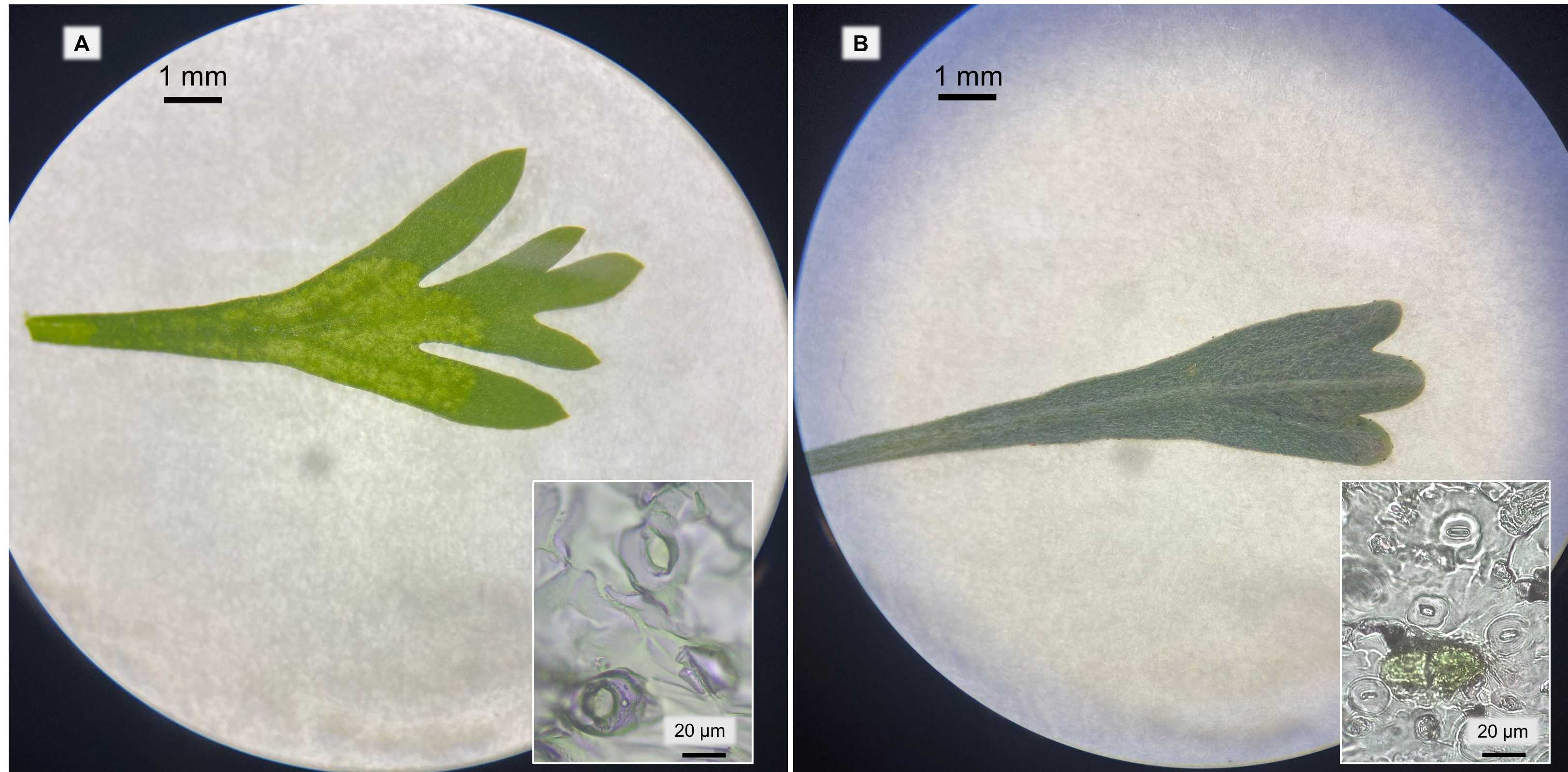
Fig 6. Image demonstrating morphological changes that occur during acclimation and hardening process. Panel A; in vitro grown leaf (thin cuticle, bright green color) and B; ex vitro leaf (trichomes, thicker cuticle layer). Leaves were imaged at 35x using dissecting scope. Insets on each panel represent stomata collected from each leaf type. Stomata for in vitro leaves are larger and occur less frequently than on the ex vitro, adapated leaves (images collected at 40x).
-
Water will be given on an as needed basis when soil water potential falls below -0.2 MPa and no more condensation can be seen on the vessel walls.
-
Plantlet can be maintained at this stage indefinitely, watering ~50mL 2-3 times per week. We advise using Teros-21 water potential probes to maintain soil water potential under -0.5 MPa (Fig. 8).
NoteBe careful here to maintain a strict watering regime since high evapotranspiration will rapidly cause soil water depletion, resulting into plantlet death by cavitation. Also, fully saturating soil could lead to an anoxic environment for the roots as well as cause fungal infections or outbreaks of other pathogens. -
After hardening (ca. 15 weeks of growth), water with 1/2 strength Hoagland modified basal salt mixture one time per week.


Completing the hardening process
Prepare silt soil
- Mix sand/silt/vermiculite (2:1.5:0.5 v/v/v) in large a plastic tub (referred to as silt soil). Add enough DI water to just moisten soil.
- Fill smaller Phyto Con vessel (473 mL) approximately 3/4 of the way full with the silt soil mixture (Fig. 8).
Note
The smaller Phyto Con vessels promote acclimatization of plantlets by alleviating any microclimate occurring in the headspace of the larger Phyto Con vessels and also supports physiological measurements (Fig. 8).
Transfer plantlet into silt soil
- Gently remove plantlet from larger Phyto Con vessel (946 mL). Roots are fine at this stage and tear easily.
- Place plantlet in smaller Phyto Con vessel (473 mL) containing the silt soil mixture. Once plantlet is in, fill to the top with additional soil.
- Water with 1/2 strength Hoagland Modified basal salt mixture until soil is moist, but no standing water is observed.
Hardening root system (Fig. 8)
- The soil water potential should be kept between -0.2 MPa and -0.9 MPa (using Teros-21 METER probe) to harden roots and complete acclimatization (Fig. 8).
Note
Falling under -2.0 MPa soil water potential will create embolism and plantlets might die from cavitation (Fig. 8).
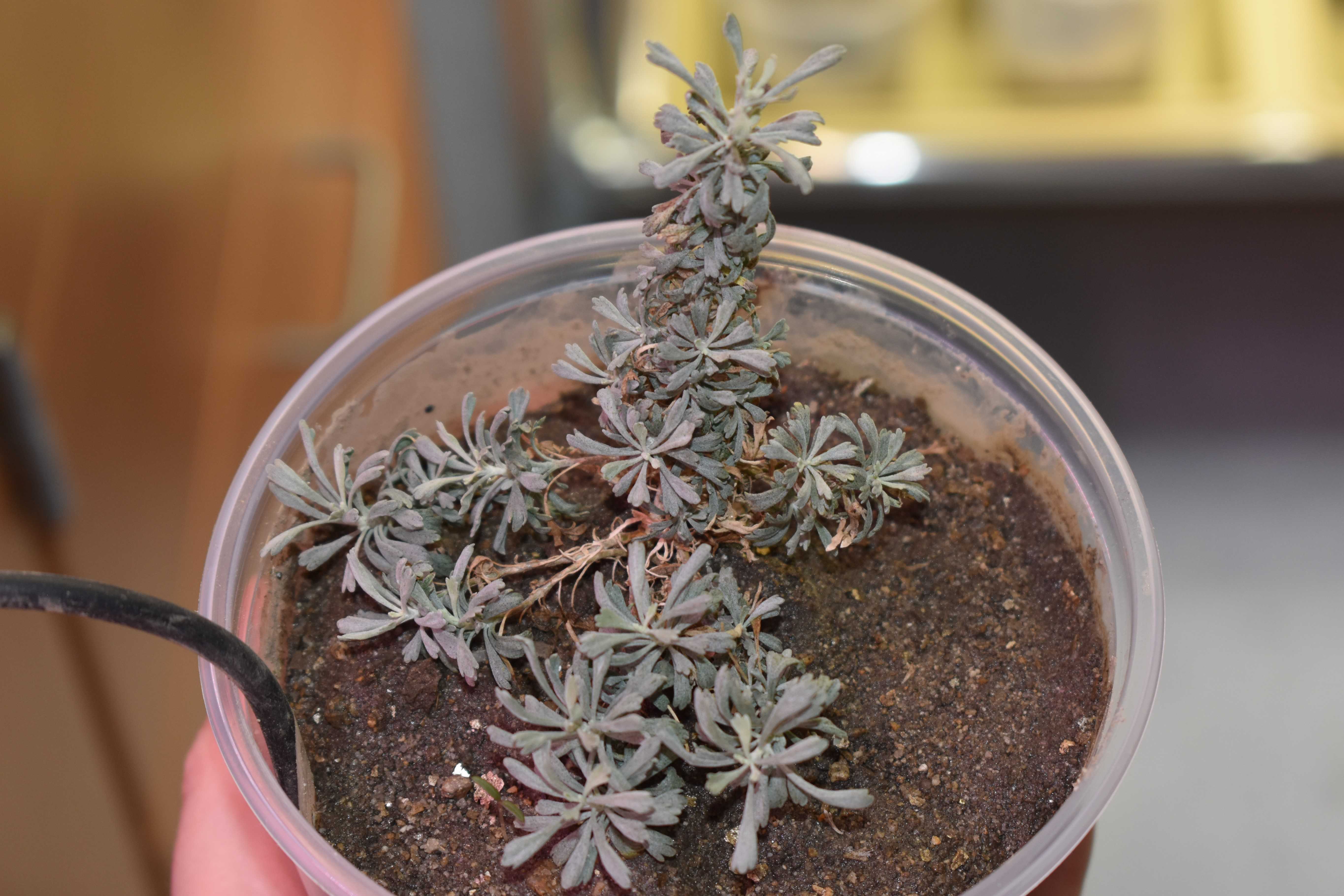
Prepare plantlets for controlled laboratory GxE experiment
Well-water plantlets
- Maintain the soil water potential below -0.1 MPa using Teros-21 METER probes to ensure plantlets are not stressed (Fig. 8).
Acclimate plantlets to growth chamber conditions
- Set plant tissue growth chamber conditions to a 16-hr photoperiod, 24°C and PAR ~128 µmol photons × s⁻¹ × m⁻² under fluorescent bulbs.
- Continue with watering regime (using Teros-21 probes) to keep plantlets in well-watered conditions (see step above and Fig. 8).
Measure shoot water potentials
Measuring shoot water potentials verifies plantlets are not experiencing water stress.
- Follow instuctions on the pressure chamber to properly attach gas hoses to the Scholander-type pressure chamber.
- Measure plantlet during mid-day.
- Cover leaves with reflective material and allow to equilibriate for 20 minutes.
- Leaving leaves covered, excise a stem from the plantlet using a razor blade.
- Feed stem through the gasket from the pressure machine. Once stem is fed through, tighten down the gasket and place back onto the pressure chamber.
- Turn the lever to chamber and adjust the rate valve to a rate that makes it easy to record values.
- When the end of the stem is wet, record the pressure displayed on the screen.
Note
Well-watered plantlets should have shoot water potentials around -1.2MPa. Note that such value would be alarming for other plant species, but it is normal/acceptable for sagebrush.
Prepare plantlets for field GxE experiments
Transfer plantlets to new vessles and soil mix
- Gently remove plantlets from large Phyto Con vessels and transfer to a (1:1 v/v/v) soil mix comprised of one part soil conditioners (one-part volcanic cinder: two-parts vermiculite: one-part peat moss) and one-part greenhouse potting mix (one-part top soil: one-part compost) into 983cm3 Deepot containers (Fig. 9).
- Move plantlets into greenhouse with 16-hr photoperiod maintained at 23° C.
- Water plantlets deeply (i.e. water drips from the bottom of the pots) every two days.

